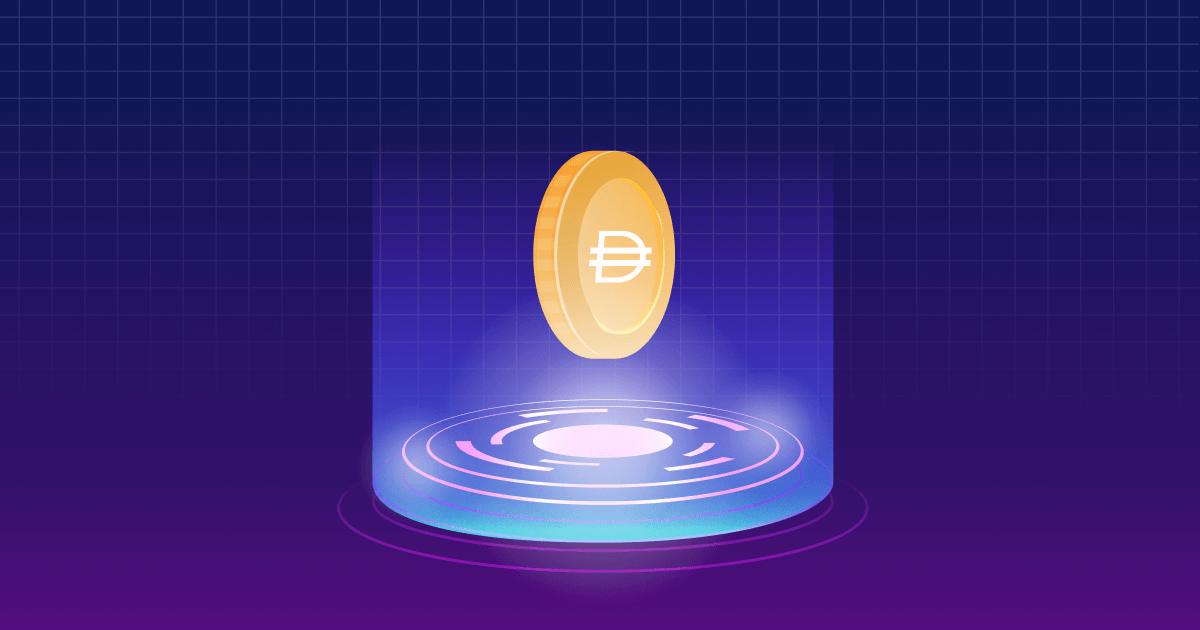
Cryptocurrencies have revolutionized the way we think about money and the financial system, but their inherent volatility has limited their use as a medium of exchange and store of value.
That’s where stablecoins come in — a new type of cryptocurrency designed to maintain a stable value pegged to an external asset, such as the US dollar or gold.
Among the many stablecoins available today, DAI stands out as a unique decentralized stablecoin that offers transparency, stability, and flexibility.
This guide will explore what DAI is, how it works, its key features and limitations, and its future roadmap.
What is DAI Coin?
DAI is a decentralized stablecoin on the Ethereum blockchain that aims to maintain a stable value relative to the U.S. dollar.
Unlike other stablecoins pegged to the U.S. dollar through centralized reserves, DAI is backed by overcollateralized cryptocurrency assets locked in smart contracts on the Ethereum blockchain. This means that DAI is not subject to the same volatility as other cryptocurrencies and can be used as a stable store of value or medium of exchange.
DAI can be used for various purposes, including sending money globally, hedging against cryptocurrency volatility, and earning interest through decentralized finance (DeFi) platforms.
History of DAI Coin
The development of DAI dates back to 2015. It is created and managed by MakerDAO, a decentralized autonomous organization (DAO) that allows anyone to participate in governing the platform. MakerDAO was founded by Rune Christensen and a team of developers.
The project aimed to create a stablecoin that would resist the volatility of other cryptocurrencies, such as Bitcoin and Ethereum.
1. December 2017: First Version of DAI
The first version of DAI was launched in December 2017 and pegged to the U.S. dollar’s value.
But, it was soon discovered that the system was vulnerable to market fluctuations and could not maintain its peg during extreme volatility.
2. November 2019: New Version of DAI
In response, MakerDAO launched a new version of DAI in November 2019, pegged to a basket of stable assets instead of just the U.S. dollar. This new version of DAI was backed by a diversified portfolio of collateral, including Ether (ETH), Basic Attention Token (BAT), and other ERC-20 tokens.
Moreover, this new system allowed DAI to maintain its peg to the U.S. dollar more effectively, even during extreme market volatility.
3. April 2023: Current Status
Since then, DAI has become a popular stablecoin in the decentralized finance (DeFi) ecosystem, with a market cap of nearly $5 billion as of April 2023.
It is widely used it for trading, lending, borrowing, and other financial activities on DeFi platforms.
Working Mechanism
In simple terms, DAI is a decentralized stablecoin pegged to the value of the U.S. dollar.
The goal is to maintain a stable value relative to the U.S. dollar, regardless of market fluctuations or changes in demand.
Here’s how the DAI coin works,
1. Overcollateralization
Users can deposit various collateral assets, such as ETH, BAT, or other ERC-20 tokens, into the MakerDAO system. These assets are overcollateralized, which means that users must deposit more collateral than the value of the DAI they wish to generate.
Thus, DAI is not backed by any centralized entity but rather by a pool of decentralized collateral transparently audited on the blockchain.
2. Vault creation
Users can create a ‘vault’ and generate DAI against their collateral once it is deposited.
The amount of DAI that can be generated is determined by the value of the collateral and the minimum collateralization ratio required by the MakerDAO system.
3. Stability fee
To incentivize users to maintain their collateral and avoid default, MakerDAO charges a stability fee on the generated DAI. This fee is paid in MKR, the governance token of the MakerDAO system.
4. DAI redemption
Users can redeem their DAI at any time by paying back the generated DAI plus the stability fee in MKR.
5. Market mechanisms
If the collateral price drops below a certain threshold, the MakerDAO system automatically liquidates the vault and sells the collateral to cover the outstanding DAI. This helps maintain the system’s stability and ensures that the value of DAI remains pegged to the U.S. dollar.
Key Features
Some of the key features of the DAI coin are,
1. Decentralization
DAI is a decentralized stablecoin created and managed by the MakerDAO community operating on the Ethereum blockchain.
Thus, DAI is not controlled by any centralized entity and is resistant to censorship, seizure, or manipulation.
2. Transparency
The MakerDAO system is transparent and auditable, which means anyone can verify DAI’s collateralization on the blockchain. This transparency helps build trust and confidence in the system and ensures that DAI remains a reliable stablecoin.
3. Flexibility
DAI can be used for various financial activities, including trading, lending, borrowing, and other DeFi applications.
It is compatible with a wide range of Ethereum-based wallets, exchanges, and DeFi platforms, which makes it easy to use and access.
4. Governance
MakerDAO is governed by the MKR token holders, who participate in the decision-making process and determine the direction of the platform. This decentralized governance model ensures that MakerDAO remains responsive to the needs and preferences of its community.
Limitations
While DAI is a popular stablecoin in the decentralized finance (DeFi) ecosystem, it has some limitations that users should be aware of.
1. Systemic risks
DAI’s stability depends on the collateral assets that back it, which can be subject to market fluctuations and systemic risks.
In extreme cases, a sharp drop in the value of the collateral could trigger a cascade of liquidations and result in a ‘black swan’ event that could destabilize the entire MakerDAO system.
2. Limited liquidity
DAI is not as widely accepted as other stablecoins, such as USDT or USDC. Thus, it limits liquidity and may make exchanging for other cryptocurrencies or fiat currencies difficult.
3. Regulatory risks
The regulatory landscape for stablecoins is still uncertain, and there is a risk that DAI could be subject to increased scrutiny or regulation.
Future Roadmap
The MakerDAO community, responsible for managing the DAI stablecoin, has a roadmap with upcoming initiatives and improvements. These include launching the Multi-collateral DAI (MCD) system, which allows DAI to be backed by various collateral assets beyond Ethereum.
In addition, the community is partnering with Optimism to improve transaction costs and speed on the platform and improve its governance system to be more transparent and inclusive.
Also, the community is exploring decentralized Oracle solutions and integrating them with other DeFi protocols to expand the use cases and increase the liquidity of DAI.
Conclusion
DAI is a unique and innovative stablecoin offering a decentralized, transparent alternative to traditional fiat currencies and other stablecoins. Its algorithmic mechanism ensures its value remains stable and pegged to the US dollar.
At the same time, its compatibility with the Ethereum blockchain and its decentralization make it a versatile and flexible stablecoin that can be used for various financial activities in the DeFi ecosystem.
As the DeFi space grows and matures, DAI will likely play an increasingly important role in providing users and investors stability, liquidity, and transparency.
FAQs
1. What is a stablecoin?
A stablecoin is a type of cryptocurrency designed to maintain a stable value relative to an external asset such as the US dollar, gold, or other cryptos.
Stablecoins are used to provide stability and reduce volatility in the crypto market and are often used as a medium of exchange, a store of value, or a unit of account in decentralized applications.
2. What is the role of smart contracts in DAI Coin?
Smart contracts play a crucial role in the functioning of DAI Coin.
The MakerDAO platform, which governs the DAI stablecoin, uses smart contracts to create and manage the DAI stablecoin. These smart contracts ensure that DAI is always backed by sufficient collateral and its value remains stable and pegged to the US dollar.
Smart contracts also enable the decentralized governance of the MakerDAO platform. It allows the community to vote on key decisions such as collateral types, stability fees, etc.
3. How does DAI Coin maintain its peg to the USD?
DAI Coin maintains its peg to the USD through over-collateralization and algorithmic adjustment.
Each DAI is backed by a collateral asset such as Ethereum, and the value of the collateral is always greater than the value of the DAI issued.
In addition, an algorithmic mechanism called the Target Rate Feedback Mechanism (TRFM) adjusts the supply of DAI based on market demand, helping to keep its value stable relative to the USD.
If the demand for DAI exceeds its supply, the TRFM increases the stability fee, incentivizing users to mint more DAI and bring its value back to the USD peg.





